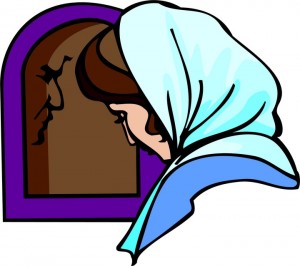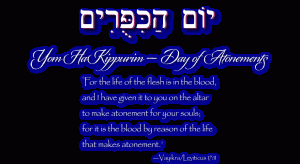Tag Archives: Day of Atonement
Video: Yom Kippur
Time to Prepare for Yom Kippur
This coming Wednesday is Yom Kippur. Are you ready?
Yom Kippur
Yom haKippurim (literally, the Day of Atonements, plural) is not a one-time thing. The redeemed believer is covered by the blood of Yeshua at the time of their initial salvation, but needs additional covering every time they sin. We need this covering of blood on an individual and collective basis.
This pattern was set in Leviticus 16 when on the Day of Atonement, the high priest made atonement for his sins, those of his family, of the nation and even the Tabernacle of Moses itself due to defilement cause by men’s sins.
We’re all in this thing together. My sin affects you and vice versa. My sins are passed on down to successive generations, and unless I break the sin cycle through the means that YHVH has provided, this sin cycle will continue as it has from Adam to this day bringing corruption, ruination, division, strife and death to all men.
Atonement and At-One-Ment—It’s About Healing Broken Relationships
The English word atone means “to make amends or reparation of wrong or injury.” Atonement biblically means “to cover, purge, make an atonement (Heb. kaphar), make reconciliation, cover over with pitch.” As with many Hebrew words, kaphar means not only to cover over sin (by the blood of the Lamb), but it means “to reconcile and purge.” When we sin, we need the forgiveness of Yeshua and his blood to pay for or to cover over our sin debt. We also need to get purged of the inclination to sin in the first place. We also need to make amends with those we’ve injured in the process of sinning—to reconcile with them, to repair the damage, and to mend the breach in the relationship. When we sin, Continue reading
The Month of Elul is here—time to prepare for the fall feasts!
Getting in Sync With YHVH Times and Seasons
What are the forty days of teshuvah (the Hebrew word meaning “repentance”) all about? Let’s briefly explore this concept to see how why they occur when they do and how they relate to the fall biblical feasts and the second coming of King Yeshua the Messiah.
During these forty days, which begin on the first day of the sixth month on the biblical calendar and end on the Yom Kippur (the Day of Atonement), it is time for the redeemed believer to get his or her spiritual house in order for the upcoming biblical high holy days. Why? Because these holidays prophetically picture the second coming of Yeshua the Messiah and his gathering his people to himself, and the coming judgments upon the earth of the wicked and lukewarm, and the pouring out of YHVH’s wrath upon the wicked along with the destruction of Babylon the Great by Yeshua. They also point to the time when Yeshua will establish his millennial kingdom on this earth, and finally, the coming of the new heaven and new earth at the end of the millennium.
Furthermore, during the forty days of teshuvah, it’s time for YHVH’s people to awake from their spiritual slumber (1 Thess 5:1–8; Rom 13:11–14) and repent (or make teshuvah) from sin and turn back to wholehearted obedience to Elohim. The three months between the biblical feasts of Shavuot or Pentecost and Yom Teruah (the Day of Shofar Blasts) prophetically pictures the 2000 year time period between the first and advents of Yeshua the Messiah. As we near the end of this period, it is time to get ready for Yeshua’s second coming and to put off spiritual lukewarmeness by repenting of sin (Torahlessness) and by putting on the robes of righteousness and looking heavenward in anticipation of our Messiah’s coming. The forty days between the first day of the sixth month and Yom Kippur is the time to be doing this.
Why forty days and why now? According to the biblical record and Jewish tradition, Moses received the tablets of the ten commandments on Shavuot (the Feast of Weeks or
How the Two Goats Point to Yeshua
Leviticus 16:7, The significance of the two goats. Why were there two goats? Do both goats represent Yeshua and the atoning work he accomplished on the cross, or will accomplish yet in the future? If so, how does each goat represent a different facet of this work? Some see in the meaning of the name azazel some satanic implications leading them to believe that this goat represents the adversary himself and his ultimate exile from mankind. This belief derives from Jewish folklore, but has no scriptural support. What does verse 10 say the azazel goat was to accomplish? Is this something Satan did? However when we read John 3:14, we see that Yeshua, while on the cross bearing the sins of the world, in a sense, became like the serpent—a picture of devil who was the first sinner and the one who led man into sin. He become man’s sin offering (see Isa 53:6,10). When this occurred, what did Yeshua accomplish in the spiritual realm for our benefit? (See Gen 3:15; Col 2:15; 1 Cor 15:54–56.)
Leviticus 16:8, The scapegoat. The Soncino Pentateuch says of the azazel goat of Leviticus 16:10 that the word scapegoat, as used in the KJV, is a poor translation and should be rendered as dismissal. In the Septuagint it is translated as the one to be sent away which agrees with the term used in the Mishnah. Azazel is not a proper name, but a rare Hebrew noun meaning “dismissal, or entire removal.” It is the technical term for the Continue reading
After Passover, why do we need the Day of Atonement?
Leviticus 16:1–34, Passover and the Day of Atonement compared. A cursory reading of the Scriptures seems to indicate that there exists overlapping similarities between some of the blood atonement ceremonies of Passover or Pesach and the Day of Atonement or Yom Kippur.
What are the differences between the sin atonement offerings of Pesach and Yom Kippur?
Perhaps realizing the fact that the Passover occurs during the spring feast day season and the Day of Atonement occurs during the fall feast day season may answer this question.
Prophetically the spring feast days picture Messiah Yeshua’s first coming, while the fall feast days prophetically point to his second coming. How does this understanding shed light on the answer to this question?
Both Pesach and Yom Kippur picture redemption through the shed blood of Yeshua; that is, being delivered from bondage to sin and the rudiments of this world.
Passover symbolizes the first steps a new believer takes when coming out of spiritual Egypt and accepting Yeshua, the Lamb of YHVH, as one’s Savior and Master.
Yom Kippur, on the other hand, pictures the blood of the Lamb covering over the sins of the individual and the corporate sins of the nation of Israel. Yom Kippur also prophetically points to the time when Yeshua will return to the earth to initiate the final regathering of lost Israel, and to prepare to marry his bride, redeemed Israel.
Perhaps this understanding will help to answer why another Passover-like feast is needed. Yom Kippur doesn’t focus so much on leaving Egypt, but rather on YHVH’s people preparing to enter the millennial kingdom under the Messiah.
Yom Kippur: Past, Present and Future
Introduction
Yom Kippur is a day of contradictions and contrasts: Joy and sorrow. Rewards for the righteous and judgments for the wicked rebels. Joy for the righteous when Satan and his demons, death and Babylon are destroyed by the King of kings.
On this day the high priest of ancient Israel went into the holy of holies of the Tabernacle of Moses (and later the temple in Jerusalem). There he sprinkled blood on the mercy seat (Heb. kapporet) and the ground seven times. Atonement was made for the high priest himself, his family as well as for all Israel. On this day the sanctuary, tabernacle, the priesthood and the all Israelites were cleansed. It represented corporate or community cleansing and entering into a deeper and more intimate relationship with YHVH.
The Passover and Day of Atonement are related though different:
Pesach (Passover) is the time of the sacrifice or atonement for personal sin—initial repentance from sins committed before being born again.
Yom Kippur (Day of Atonement) is the time of the atonement or covering of the individual’s as well as the corporate sins of Israel committed in ignorance (Heb 9:27) during the past Continue reading






